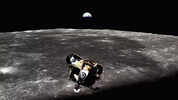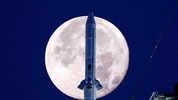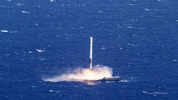Isro's Chandrayaan 3: How the moon landing will trigger a new age of lunar exploration

There is a story that your correspondent heard from a senior Isro official
a few years ago.
In late 2003, when the then Prime Minister Atal Bihari Vajpayee
was presented with the proposal for India’s orbital mission
to the moon for approval, he just made one change in it.

He suffixed a number to the name. Chandrayaan 1.

He wanted to make sure that this project was not viewed as a one-off,
that Chandrayaan was going to be the first of India’s interplanetary missions.
It was.
The fire of space exploration was lit in India with that one step.
Chandrayaan 1, Chandrayaan 2; Mangalyaan; Aditya L1, and future missions like
Shukrayaan 1, are all a result of that shift in India and Isro’s strategy in space - from
focusing purely on utilitarianism - communication/weather/remote sensing satellites - to also enabling exploration.

While the first Chandrayaan mission was a success, the second one which had attempted to soft-land, unfortunately failed. This was due to a software glitch in the final stages of the mission as it attempted a landing.
For those who came in late, soft-landing on the moon is a notoriously difficult feat. Only three other countries — the United States, Russia, and China — have previously performed a controlled touchdown
on the lunar surface.
Poised to achieve that is Chandrayaan 3.
Unlike the first Chandrayaan mission, which rode atop a PSLV (polar satellite launch vehicle) both missions 2 and 3 have been launched using GSLV (geosynchronous satellite launch vehicle), or LVM-3 (launch vehicle mark-3) as that rocket has since been renamed.
The spacecraft was housed inside the nose cone of the LVM-3.
Chandrayaan 2’s failure resulted in Isro simplifying the mission profile of its latest attempt.
For instance, while Chandrayaan 2 had an orbiter, lander, and a rover, Chandrayaan 3 will only carry a lander — Vikram — and a rover — Pragyan — attached to a propulsion module.
Consequently, the number of scientific payloads also decreased. In Chandrayaan 2, there were as many as eight payloads on the orbiter, a further four on the Vikram lander and two more on the rover. In the current mission the number of payloads on the lander is three, with two on the rover and just one on the propulsion module.
Clearly, the effort is to simplify the mission and focus on demonstrating the soft-landing capabilities of the spacecraft.
The launch took place on July 14 this year.
Launch
Launch
The spacecraft was successfully placed into an orbit around the earth. Over time, a series of orbital raising manoeuvres were done by firing the propulsion module’s thrusters for a limited time. This finally led to a manoeuvre known as trans-lunar injection, through which the spacecraft was placed on a path towards the moon.
At about 100km from the moon, the spacecraft decelerated and performed a manoeuvre called lunar orbit capture. Once captured by lunar gravity, the Vikram spacecraft separated from the propulsion module and was injected into an orbit around the moon.
It then performed a series of orbit-lowering bursts from its thrusters. The final few minutes will be a ballet controlled by software on board, using data collected from a number of sensors that will look for ideal surface conditions to set the spacecraft down softly.
Landing
Landing
If all goes well, the Pragyan rover will then be released onto the lunar surface from
where it will take in an unparalleled view of the earth.

The reason the landing is scheduled for August 23 is to make sure that it coincides with the lunar dawn. The timing is critical, as the spacecraft will generate its power from onboard solar panels. Lunar days last 14 earth days, which is the expected length of the mission.
As lunar nights are cold, there is no guarantee that the electronics aboard the lander and rover can survive the lunar night, so a landing at dawn is critical to maximise the mission’s duration.
Now let's set some context to India's and the world's return to the moon.
ICYMI, Chandrayaan isn’t the only Indian effort that has aimed for the moon. From 2010 to 2018, a privately funded Bengaluru-based entity, TeamIndus, had developed a mission to soft-land a spacecraft on the moon.
TeamIndus was one of the competitors of Google Lunar XPrize, a USD30 million competition, which would reward the world’s first privately funded mission to soft-land on the moon, move about on the lunar surface, and beam high-definition images back.
Funded by the likes of Nandan Nilekani and Ratan Tata, among others, TeamIndus pushed itself to become one of the top teams in the competition. With a team of former Isro engineers and scientists (including the mission director of the first Chandrayaan mission) who worked with a set of young aerospace engineers, TeamIndus was a pioneer of the New Space revolution in India.
TeamIndus developed a spacecraft and a lunar rover, ECA. In late 2015, it even contracted Isro’s PSLV for a launch. Unfortunately, space is an expensive proposition. Despite raising around USD20 million, there was just not enough money to achieve its mission. Risk capital in India, at the time, was shy of backing a space company, with its long road to profitability and higher-than-normal amount of risk.
Zooming out further, the world seems to have fallen in love with the moon all over again. Why?
From the first Pioneer mission from the US in 1958 till 1978, there were a total of 99 missions which had a lunar component. This rather high number was primarily a result of the flames of the Cold War stoking the space race between the US and Russia. While many of these missions were failures, the peak of the era was of course Neil Armstrong and his 1969 moon landing.

The US had more or less won the space race by the early 1970s, and after the Vietnam War was more conservative in spending money. At its peak, the Apollo programme is estimated to have cost the US around 4% of its GDP. Russia took a retreat as well.
All this meant that from 1978 till 1990, there were no moon missions. None. The 1980s were truly barren when it came to lunar exploration.
In the 1990s there were seven missions. The first decade of this millennium saw 10 missions. The whole of the last decade saw 12.
Then there is 2023.
There are as many as six missions to the moon scheduled for just this one year. A mission from the European Space Agency (ESA) is currently ambling towards earth’s moon, which it will fly by on its way to Jupiter’s moon Ganymede.
Three more missions are scheduled for the year, including one from the Japanese Aerospace Exploration Agency (JAXA) and two led by private American companies Intuitive Machines and Astrobotic Technologies.

Then there is the biggest mission of them all that is underway — Nasa’s Artemis missions — which will aim to land the first woman and the first person of colour on the moon over the next few years.

So, why is everyone wanting to go back to the moon? Why is the moon back in vogue?

There are many reasons. A key one is the reduced cost of access to space. According to a 2018 study by Texas Tech University, “Nasa’s space shuttle had a cost of about USD1.5 billion to launch 27,500kg to low earth orbit (LEO), USD54,500/kg. SpaceX’s Falcon 9 now advertises a cost of USD62 million to launch 22,800kg to LEO, USD2,720/kg. Commercial launch has reduced the cost to LEO by a factor of 20.”
This cost has since come down further. India always has a low cost of access to space, but the real impact of the lowering of this cost across the world has been the peaking of interest of the private sector.

The private sector is not doing it for the sake of exploration. There is a regeneration of commercial interest in space, and many early movers see moon missions as something of a technology demonstrator, which will help them fund a space-based business. This could be anything from mining asteroids for precious metals or even the moon for Helium 3, an isotope that can theoretically be a source of energy in nuclear fusion.
Astrobotic Technologies, for instance, defines itself as a space courier of sorts which is in the “business of delivering your scientific instruments, technologies, ideas, and innovations to space”.
Underpinning all of this are key macro trends such as increased capabilities in robotics, artificial intelligence, and miniaturisation.
Moon stations are in the plans of many countries. But to establish that, there will first have to be research into whether water that is present on the moon can be recaptured. There is also research going into how moon rocks, soil etc. can be used as building materials for such stations. The viability of the moon as a refuelling stopover en route to other planets is also being looked into.

Then there are geopolitical interests. China’s success with its Chang’e missions has spooked countries such as the US, which fear that ceding ground to the Chinese in space exploration would be a serious strategic mistake.
Thus Artemis.
Clearly missions to the moon are going to be in the news for a long, long while.

(Images and videos from Reuters, Isro, and Getty Images)
